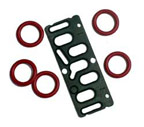
|
7108
S. Alton Way, Unit I |
(303) 758-2728
Home > O-ring, Seal Design > Vacuums > Permeation
Vacuum Permeation
The solubility and diffusion of a gas through an elastomer affects the pump-down time as well as the ultimate vacuum achieved in a vacuum seal. The gas permeation coefficient of a polymeric material is the volumetric flow rate of a gas under steady-state conditions through a unit surface area of unit thickness at unit pressure difference.
Q = K A (P1 - P2) d
Q is the permeation rate (cm3/sec)
K is the permeation coefficient (cm3 cm/sec cm2 atm)
A is the area (cm2)
P1 - P2 is the pressure gradient (atm)
d is the thickness (cm)
 |
Permeability is a fundamental property of an elastomer. It is often desired to measure the rate of transmission of a vapor or liquid through the elastomer. This is called "transmission." In general:
|
| Material | He | O2 | H2O | N2 | CO2 |
| Nitrile | 8 | 2.5 | 760 | 0.1 | 25 |
| EPDM | 25-30 | 16-18 | - | 6-7 | 85 |
| VMQ | 250 | 75-450 | 8,000 | 200 | 2,000 |
| FVMQ | 140 | 80 | - | 40 | 400 |
| FKM | 9-22 | 1-2 | 40 | 0.05-0.7 | 5 |
| FKM* | 30 | 3 | - | 2 | - |
| FFKM (PFE) | 60-80 | 6-8 | 90-100 | 8-12 | - |
| KEL-F | - | 0.1 | - | 0.1 | 0.5 |
| PTFE | - | 0.04 | - | 0.14 | 0.12 |
| Polyimide | 1.9 | 0.1 | - | 0.03 | 0.2 |
Permeation
Data for Various Polymers
(units expressed in 10-8 sccm-cm/sec-cm2-atm)
*Highly
fluorinated compound
Next Topic Outgassing and Weight Loss of Elastomers
We are located in the Denver Technological
Center in a suburb of Denver, Colorado
©1997-2017, Problem Solving Products, Inc.
Website Map | Privacy Statement
| Terms of Use

